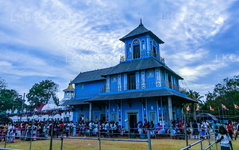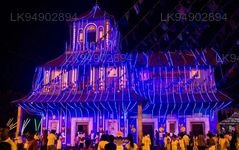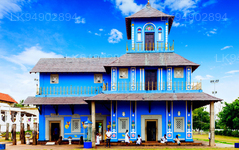
Kandy City
Kandy, a picturesque city in central Sri Lanka, is renowned for its rich cultural heritage, vibrant festivals, and scenic beauty. Nestled amidst lush hills, it is home to the Temple of the Tooth Relic, a UNESCO World Heritage Site, and offers a captivating blend of history and natural splendor.
Maha Vishnu Devalaya
On to the North-West of the palace, in front of the “Natha Devale“ is the “Vishnu Devalya” popularly a the “Maha Devale”. This is one of the Hatara Devale in the Kandy, the other three being the Natha, Kataragama and Patini. These four Devalayas have a long association with the Royal Palace ( Maha Vasala) and the Temple of Tooth Relic (Sri Dalada Maligawa) and has been venerated by Buddhists and Hindus alike from the inception.
Different historical documents have called this deity and the Devale by different names. Robert Knox, the English Prisoner has called the deity in this devale “Aluth Nuwara Deiyo”. According to legend the “Aluth Nuwara Deviyo” was brought to Aluth Nuwara in Kegalle District from Devinuwara in Matara. This deity was called “Upulvan Deiyo” (deity with a colour of a lotus). Later this deity in Aluth Nuwara was known as “Vishnu”. The 15th century “Paravi Sandeshaya”, a poetical work describes the deity at Devinuwara, Matara as a destroyer of Asura. Thus it can believed that this same deity is also “Rama” of the great Indian Epic “Ramayana”. Interestingly “Ehelapola Varnanawa”, a poetical work done in the 19th century calls this shrine at Kandy, “The Rama Devale”. It is also interesting to note that this devale has had in possesion a cloth painting depicting the Battle of Rama and Rawana.
“According to Mahavansa, The great chronicle of Sri Lanka, It was “Upulvan Deiyo” thus Vishnu that was selected as the guardian to protect the land of Sri Lanka and Buddhism within it at the time of Buddha’s passing away.
“When the Guide of the World, having accomplished the salvation of the whole world and having reached the utmost stage of blissful rest, was lying on the bed of his nibbana; in the midst of the great assembly of gods, he, the great sage, the greatest of those who have speech, spoke to Sakka’ who stood there near him: `Vijaya, son of king Sihabahu, is come to Lanka from the country of Lala, together with seven hundred followers. In Lanka, O lord of gods, will my religion be established, therefore carefully protect him with his followers and Lanka.
When the lord of gods heard the words of the Buddha he from respect handed over the guardianship of Lanka to the god who is in colour like the lotus.
According to beliefs, Vishnu is a future Buddha after Natha. Therefore Vishnu always has had a high ranking within the deities worshipped by the Sri Lankans. During the Kandyan Era the the Kings “Abisheka Mangallaya” or the Coronation Ceremony was held at this Maha Devale.
The origin of Vishnu Devalya or the shrine of Vishnu is unclear. This is a long building with a storied sanctum at the end. In front the sanctum is a long hall called “dig-ge”. This hall is for dancers and who carry out puja for the deity. Today it is used by the devotees to pray. This building complex is entered through a two storeyed Vahalkada (entrance doorway), to an open hall with timber columns in the middle terrace, a beautifully carved stone flight of steps and the drumming hall. On the upper terrace is another small shrine, the God Dedimunda’s Shrine and a large Bo-tree.
About Kandy District
Kandy district is situated in the centrel province of Sri Lanka. One of the seven World Heritage Sites in Sri Lanka, Kandy was once home to the Kandyan Kings of yore in the 16th-century and a fountainhead for all the music, arts, crafts and culture in the country. About 129 km away from Colombo, Kandy is ensconced amongst a hilly terrain and all eyes are drawn to the centre of the city, where the Kandy Lake forms a charming feature. Kandy retains great religious significance for Sri Lanka, because it is in this charming city that the Dalada Maligawa or "Temple of the Tooth" is located, within which the sacred tooth relic of Lord Buddha lies well guarded.
The Royal Botanical Garden, Peradeniya is situated about 5 km to the west of the city centre at Peradeniya and is visited by 1.2 million people per year. It is the largest botanical garden on the island. The Udawatta Kele (Udawatta Forest) is a protected sanctuary situated in the heart of the city, just north of Temple of the Tooth.
Kandy is a Sinhala majority city; there are sizeable communities belonging to other ethnic groups, such as Moors and Tamils. Kandy is second only to Colombo the center of the Sri Lankan Economy. Many major co operations have large branch officers in Kandy and many industries include textiles, furniture, Information Technology and jewellery are found here. Many agriculture research centers are located in the city.
And a fountainhead for all the music, arts, crafts and culture in the country. About 129 km away from Colombo, Kandy is ensconced amongst a hilly terrain and all eyes are drawn to the centre of the city, where the Kandy Lake forms a charming feature. Kandy retains great religious significance for Sri Lanka , because it is in this charming city that the Dalada Maligawa or Temple of the Toothis located, within which the sacred tooth relic of Lord Buddha lies well guarded.
About Central Provincce
The Central Province of Sri Lanka consists primarily of mountainous terrain. The province has an area of 5,674 km², and a population of 2,421,148. Some major towns include Kandy, Gampola (24,730), Nuwara Eliya and Bandarawela. The population is a mixture of Sinhalese, Tamil and the Moors.
Both the hill capital Kandy and the city of Nuwara Eliya are located within the Central Province as well as Sri Pada. The province produces much of the famous Ceylon tea, planted by the British in the 1860s after a devastating disease killed all the coffee plantations in the province. Central Province attracts many tourists, with hill station towns such as Kandy, Gampola, Hatton and Nuwara Eliya. Temple tooth or Dalada maligawa is the main sacred place in Centrel province.
The climate is cool, and many areas about 1500 meters often have chilly nights. The western slopes are very wet, some places having almost 7000 mm of rain per year. The eastern slopes are parts of the mid-dry zone as it is receiving rain only from North-Eastern monsoon. The Temperatures range from 24°C at Kandy to just 16°C in Nuwara Eliya, which is located 1,889 m above sea level. The highest mountains in Sri Lanka are located in the Central Province. The terrain is mostly mountainous, with deep valleys cutting into it. The two main mountain regions are the central massif and the Knuckles range to the east of Kandy.


























